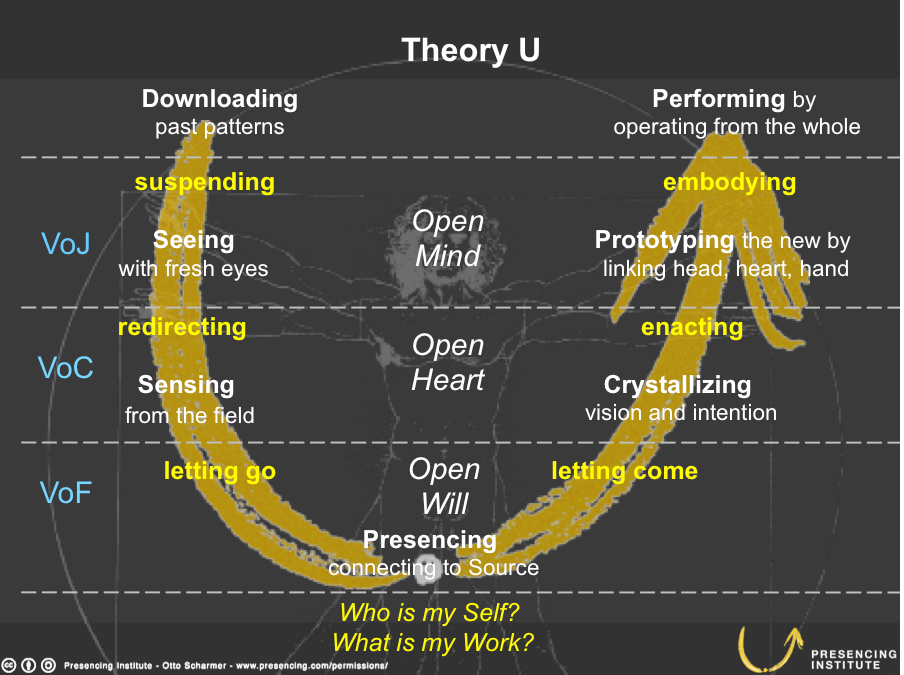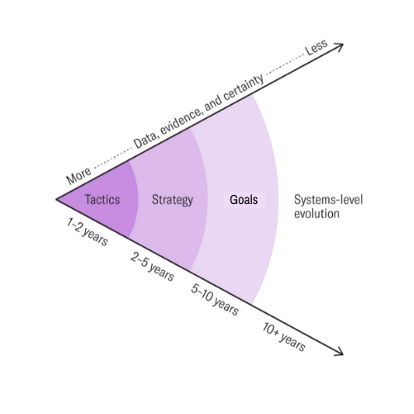By Molly Penn
It is human nature to crave control, avoid uncertainty, and envision a tidy future. Even after a two-year rollercoaster of disruption and chaos, many organizational leaders are still looking to their strategic plans and SMART goals to keep them on a clearly crafted course toward a too-specific future.
NYU professor of strategic foresight Amy Webb, in her Harvard Business Review article “How to Do Strategic Planning like a Futurist,” explains what can happen to leaders who address long-term risk with short-term solutions: “Teams that rely on traditional linear timelines get caught in a cycle of tactical responses to what feels like constant change being foisted upon them from outside forces. Over time, those tactical responses—which take significant internal alignment and effort—drain the organization’s resources and make them vulnerable to disruption.”
Leaders experienced such vulnerability at the onset of the COVID-19 pandemic, and they are still recovering. Some are once again tightening their grip on what they can control, while others have chosen to embrace disruption as a precursor to transformation.
The transformative state
Simply put, organizational transformation is the act of moving your organization from where you are now to where you will need to be in the future in order to stay relevant and meet the needs of your future stakeholders and constituents. Significantly, it also relies on the connection of our idea of “self” to our work. Transformation is big, scary, and hard to measure. Effectively transitioning from a state that celebrates specificity to a culture that embraces transformation requires a significant investment of time and resources.
But the work required for true organizational renewal is always worth it. As you look ahead, consider a new way to face the future: a focus on transformation above measurability. Below we explore two approaches that can help you achieve a more transformative approach: Theory U and foresight.
Theory U and transformation
Created by MIT professor Otto Scharmer, Theory U is a learning and change management philosophy used by leaders around the world to drive transformation. Based on 150 interviews with entrepreneurs and innovators in science and business, Scharmer and his colleagues at MIT pioneered the basic principles of Theory U to help institutions break through past unproductive patterns of behavior and decision making.

The idea of “presencing” is integral to Theory U. It is depicted in the above diagram as a journey away from one’s institutional bubble, down to a greater connection with one’s self, and up to a new state of being. The core elements of Theory U include:
- Co-initiating common intent by stopping and listening to others and to what life calls one to do (seeing with fresh eyes)
- Co-sensing the field of change by going to the places of most potential and listening with one’s mind and heart wide open (sensing from the field)
- Presencing inspiration and common will by allowing the inner knowing to emerge (connecting to our source intentions)
- Co-creating strategic microcosms by prototyping the new to explore the future by doing (vision and intention
- Co-evolving through innovations with ecosystems that facilitate seeing and acting from the whole (linking head, heart and hands and operating from the whole)
When applied to organizational system transformation, Theory U is about increasing engagement, building trust, and helping individuals within that system tap into what they are being called to do and to adopt new patterns. The seven key stages—downloading, seeing, sensing, presencing, crystalizing, prototyping, and performing—illustrate how business transformation isn’t about merely creating new processes or rebuilding a particular model, but engaging all people in an organization in the process of renewal. It requires leaders who can let go of their ego, allow themselves to see possibilities through other perspectives, experiment over and over again, and invest the hard work of rebuilding more healthy norms in the current culture.
The futurist approach to planning
Futurism involves modeling next-order outcomes using a broad spectrum of weak signals, strong signals, trends, and other factors. Futurism is not about making predictions – but rather projections in order to create a state of readiness, to determine strategic actions, to aid in decision-making, to build long-range plans, or to simply imagine alternate future states.
Futurism enables organizations to detect disruption early and interpret its possible effects for ongoing business transformation. Futurists use a foresight approach to ensure the organization thrives in the long-term, while simultaneously executing successfully in the present.
Futurism operates in the present-future balance as illustrated by the below time cone diagram from Future Today Institute. This diagram shows a different method for planning ahead—one that replaces thinking linearly with considering the short- and long-term simultaneously. As you can see, tactics involve the shortest time frame and are therefore the most certain outcomes. As you move up from tactics through strategies, goals and towards systems level evolution, your outcomes become much longer term and therefore harder to measure with any degree of certainty.

Leaders must be willing to accept more uncertainty as they continually reset goals with an eye toward systems-level evolution for the longer-term future. Understanding systems-level disruption includes having a strong sense of how the industry must evolve to meet the challenges of new technology, market changes, and other external forces.
Webb explains: “As you gain data and evidence and as you make progress on your actions, the beginning of the cone and your tactical category is always reset in the present day. The result, ideally, is a flexible organization that is positioned to continually iterate and respond to external developments.”
Specific and transformational?
While it is possible to apply transformational thinking to traditional strategic planning, leaders must understand there will always be a tension between specificity and transformation (see our blog post on Navigating Complexity in the Social Sector). Additionally, equity considerations often complicate measurability—some measurability of equity initiatives is important to benchmark progress, but too much measurability may drive performative practice versus deep transformation.
We at Penn Creative Strategy understand how challenging it is to transition from a state of controlled, measurable planning to one of transformation and foresight for the future. We have partnered with dozens of clients to help them increase their systemic capacity for transformation through their approaches to strategy, process, and culture. Contact us to learn more.
